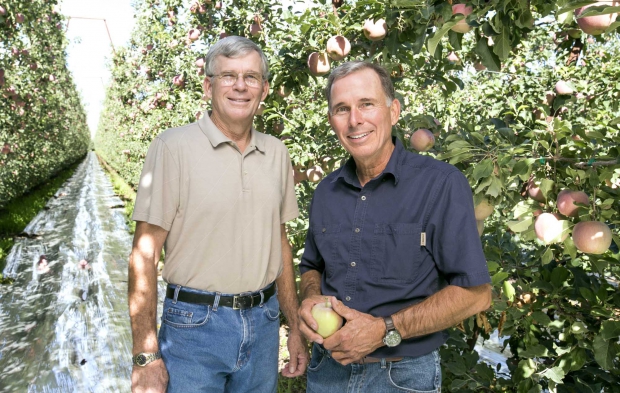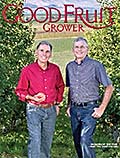
Craig and Mike O’Brien at their orchard near Prosser, Washington. (TJ Mullinax/Good Fruit Grower)
Neither Craig nor Mike O’Brien likes to be in the spotlight.
For the past 40 years or so, the brothers have been quietly dedicating themselves to figuring out how to grow the highest yields of the best quality tree fruit.
Ironically, their efforts have caught the attention of growers far and wide and earned them the title of Good Fruit Growers of the Year for 2014.
2014 Grower of the Year
conference in 2011.
“I’m not one who likes to jump up in front of a crowd,” said Craig, noting that Mike always felt the same way. But the brothers gladly demonstrate what hasn’t worked out for them, as well as what has, and say the information flows both ways.
Award
The Good Fruit Grower of the Year award is made annually by Good Fruit Grower magazine to an innovative and inspiring grower or family in North America and is presented during the Washington State Horticultural Association’s annual meeting in December. The magazine’s advisory board makes the selection. Dr. Jim McFerson, manager of the Washington Tree Fruit Research Commission and a member of the advisory board, said anyone who’s ever worked with the O’Briens is inspired by their quiet dedication and perseverance.
“It’s so impressive for a farming operation to do what they’ve been able to do, with no fanfare and no hoopla,” he said. “They’re sincere and genuine people. It makes you confident about the future that we have growers like these.”
The O’Briens are deeply rooted in Washington State farming, beginning with their grandfather, James, and continuing with their father, George, who experimented with ways to plant trees at higher densities. Mike, 65, joined the family business right after college, while Craig, 61, spent time in Seattle with Nordstrom before joining the farm.
High density
From the onset as orchardists, the O’Briens embraced their father’s commitment to innovation, especially with tree density, and put their ideas in practice with longtime orchard manager Jesus Lamas. By the 1980s and 1990s, they were planting trees five to six feet apart with 13 or 14 feet between rows.
After visiting Rob Dawson, an orchardist in British Columbia, Canada, where the super spindle system had been successfully adopted, they tightened their spacing again.
More Stories |
| – Collaborative approach – Change is guaranteed – Who will pick the fruit? |
In the spring of 2000, the brothers removed 40 acres of Red Delicious (about 20 percent of their apple acreage) and replanted with Buckeye Gala on a spindle system with two feet between trees and ten feet between rows. To minimize tree cost, they planted Malling 9-337 rootstocks—more than 87,000 of them—in place and budded them using budwood that was flown in from Ohio, as there was not enough of the variety available in Washington.
The planting required a huge investment, in a year when apple returns were poor.
Mike admits he was motivated not just by the need to improve per-acre production and returns, but by his love of trying new things and tendency to think outside the box horticulturally.
“It’s the excitement of trying something new,” Mike said. “But there’s also the trepidation of the mistakes you make when you try something that’s not proven.
“We were sweating bullets,” he recalled. “For this size of operation, which is just short of 400 acres—that was a very expensive, big move. But you have to do what you have to do, and hopefully you can make it work. When you invest huge amounts of money in trellis and trees, you’ve got to get them to grow and manage them.”
Planting in place helped reduce the tree cost, but in effect gave them a large nursery to tend to. “When you have a 40-acre nursery, it’s scary,” Mike said. “If you don’t control the weeds you can have a disaster. Those rootstocks, they’re just tiny guys.”
Planting with thousands of trees per acre felt like a big risk. But not innovating is a greater one, Craig believes.
“I think it may be equally, if not more risky not to plant enough trees per acre,” he said. “High yields of high quality fruit are what we’re after. We’re competing for survival. We’re quite small in the Washington tree fruit industry, and to be viable in the future we certainly need to be efficient.”
Learning experience
The planting was not only a great success but a big learning experience.
They found that trees grow more vigorously in their site than in British Columbia. They learned how to keep the trees in their limited space and avoid shading by using the growth regulator Apogee (prohexadione calcium).
They learned that tree rows a quarter of a mile long need posts closer than 50 feet apart, so they put short posts in between. And with a yield potential of over 100 bins per acre, the posts had better be sturdy. They switched to bigger wooden poles in the rows and metal end posts.
They learned that the upright spindle system is better suited to Gala than Fuji, which, because of its tip-bearing growth habit, has done better on a V trellis system. They’ve had higher yields from their V plantings, but it’s still not clear if the extra establishment and training costs for a formal system are offset by the additional yield, Mike said.
They say Del Feigal, manager of Auvil Fruit Company’s Vantage ranch, has been a great resource for them, as have their Wilbur-Ellis horticulturists.
Craig has found that Gala does well on a spindle system with a spacing of 2-by-9-feet, or a little closer in the row. A row spacing of just under nine feet is the narrowest that can still accommodate the standard 4-foot wide picking bins and tractors.
Their aim is to have the trees grow to the top wire in the first two years. With Gala, they can harvest a few apples in the second leaf and have a commercial crop in the third year, whereas with Fuji, it takes a few years for the trees to settle down and produce high-quality fruit.
They do blossom thinning by hand and adjust the crop to a specific number of apples per tree during touch-up fruit thinning.
Keith Oliver, who manages the neighboring orchard owned by Olsen Brothers, said the O’Briens have figured out how to produce exceptionally high yields and large fruit.
“They’ve been very aggressive about pushing yields and very successful at doing it,” he said. “They have a problem that their Galas are too big, which is unheard of. A lot of people can grow big Fujis, but there’s not a lot of people who can grow big Galas.”
Craig said he’d hesitate to plant any orchard at a density of less than 2,000 trees per acre, for fear of not achieving his target yields.
“It’s very attainable to produce 80 to 100 bins per acre in these new systems,” he said. “A hundred bins per acre is not out of the question, and I believe some of the V-trellis systems can exceed that. We have some spindle and V-trellis plantings that are spaced three feet apart where we struggle to get the yields. Today, I would plant the spindle trees two feet part and the V-trellis systems no further than 18 inches apart.”
Last spring, he planted Gala on a 1-by-10-foot spacing. He will install a steel V-trellis and lean the trees at a 73-degree angle in alternate directions and grow them in a spindle fashion with random limb placement.
“We’ve continually placed our trees closer and closer together,” Craig said. “We may finally find how close too close is.” •
———
Read about past Good Fruit Growers of the Year.







Awesome, well deserved!
Super orchardists — super people.
Ike & Jan Boone
Issaquah, WA